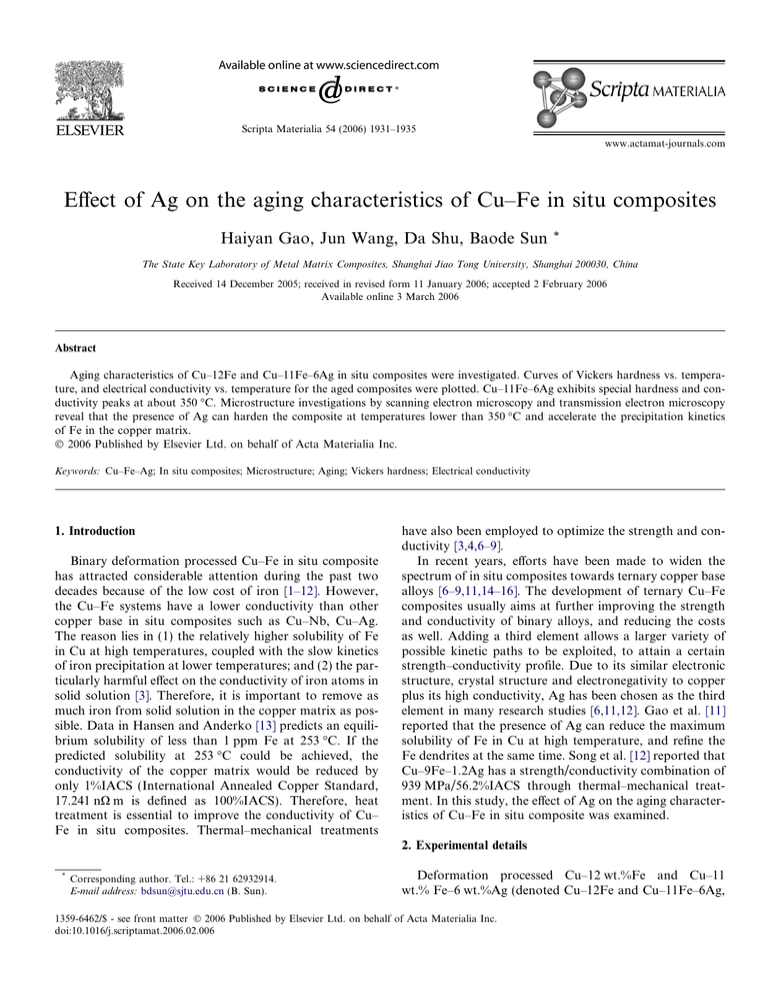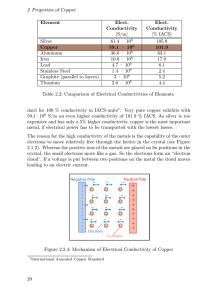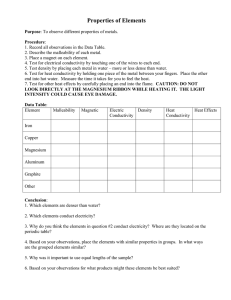Preview Free (First 2 Pages PDF)
advertisement

Scripta Materialia 54 (2006) 1931–1935 www.actamat-journals.com Effect of Ag on the aging characteristics of Cu–Fe in situ composites Haiyan Gao, Jun Wang, Da Shu, Baode Sun * The State Key Laboratory of Metal Matrix Composites, Shanghai Jiao Tong University, Shanghai 200030, China Received 14 December 2005; received in revised form 11 January 2006; accepted 2 February 2006 Available online 3 March 2006 Abstract Aging characteristics of Cu–12Fe and Cu–11Fe–6Ag in situ composites were investigated. Curves of Vickers hardness vs. temperature, and electrical conductivity vs. temperature for the aged composites were plotted. Cu–11Fe–6Ag exhibits special hardness and conductivity peaks at about 350 °C. Microstructure investigations by scanning electron microscopy and transmission electron microscopy reveal that the presence of Ag can harden the composite at temperatures lower than 350 °C and accelerate the precipitation kinetics of Fe in the copper matrix. Ó 2006 Published by Elsevier Ltd. on behalf of Acta Materialia Inc. Keywords: Cu–Fe–Ag; In situ composites; Microstructure; Aging; Vickers hardness; Electrical conductivity 1. Introduction Binary deformation processed Cu–Fe in situ composite has attracted considerable attention during the past two decades because of the low cost of iron [1–12]. However, the Cu–Fe systems have a lower conductivity than other copper base in situ composites such as Cu–Nb, Cu–Ag. The reason lies in (1) the relatively higher solubility of Fe in Cu at high temperatures, coupled with the slow kinetics of iron precipitation at lower temperatures; and (2) the particularly harmful effect on the conductivity of iron atoms in solid solution [3]. Therefore, it is important to remove as much iron from solid solution in the copper matrix as possible. Data in Hansen and Anderko [13] predicts an equilibrium solubility of less than 1 ppm Fe at 253 °C. If the predicted solubility at 253 °C could be achieved, the conductivity of the copper matrix would be reduced by only 1%IACS (International Annealed Copper Standard, 17.241 nX m is defined as 100%IACS). Therefore, heat treatment is essential to improve the conductivity of Cu– Fe in situ composites. Thermal–mechanical treatments have also been employed to optimize the strength and conductivity [3,4,6–9]. In recent years, efforts have been made to widen the spectrum of in situ composites towards ternary copper base alloys [6–9,11,14–16]. The development of ternary Cu–Fe composites usually aims at further improving the strength and conductivity of binary alloys, and reducing the costs as well. Adding a third element allows a larger variety of possible kinetic paths to be exploited, to attain a certain strength–conductivity profile. Due to its similar electronic structure, crystal structure and electronegativity to copper plus its high conductivity, Ag has been chosen as the third element in many research studies [6,11,12]. Gao et al. [11] reported that the presence of Ag can reduce the maximum solubility of Fe in Cu at high temperature, and refine the Fe dendrites at the same time. Song et al. [12] reported that Cu–9Fe–1.2Ag has a strength/conductivity combination of 939 MPa/56.2%IACS through thermal–mechanical treatment. In this study, the effect of Ag on the aging characteristics of Cu–Fe in situ composite was examined. 2. Experimental details * Corresponding author. Tel.: +86 21 62932914. E-mail address: bdsun@sjtu.edu.cn (B. Sun). Deformation processed Cu–12 wt.%Fe and Cu–11 wt.% Fe–6 wt.%Ag (denoted Cu–12Fe and Cu–11Fe–6Ag, 1359-6462/$ - see front matter Ó 2006 Published by Elsevier Ltd. on behalf of Acta Materialia Inc. doi:10.1016/j.scriptamat.2006.02.006 1932 H. Gao et al. / Scripta Materialia 54 (2006) 1931–1935 respectively) in situ composites were investigated. Hemispherical ingots of about 20 mm in diameter were separately prepared from electrolytic Cu, commercial Fe and Ag with at least 99.9 wt.% purity using tungsten arc-melting in an atmosphere of ultra high purity argon. The ingots were hot forged, cold rolled and then drawn to a diameter of 2 mm with a draw ratio of g = 4.1, where g = ln(A0/Af), A0 is the initial sectional area obtained after hot forging and Af is the final sectional area. Details of the materials preparation can be found elsewhere [11]. Specimens for the aging treatment were sealed in quartz tubes, which were evacuated to a vacuum of 104 Torr, to avoid oxidation. Samples of each composite were annealed at various temperatures between 150 °C and 700 °C for 1 h and quenched into water. Longitudinal Vickers hardness measurements were performed on an HXD-1000 microhardness tester using a load of 200 g. Each hardness value was calculated from an average of at least ten indentations with deviation being within 4%. Electrical resistivities of samples were measured using a ZY9858 digital micro ohmmeter with precision of 1 lX at room temperature, and the corresponding conductivity was evaluated according to the definition of IACS. Microstructures of the samples were investigated using a Sirion 200 field emission scanning electron microscope (FESEM), a JEM-2000EX transmission electron microscope (TEM) and a JEM 2010F field emission transmission electron microscope (FETEM). TEM specimens were prepared by mechanical thinning and ion milling on a liquid nitrogen stage using an incidence angle of 10° and 4° for enlarged thin areas. 3. Results Vickers hardness vs. quenching temperature for the two composites is plotted in Fig. 1. Ternary Cu–11Fe–6Ag exhibits a different response to temperature from that of binary Cu–12Fe. In the range 150–600 °C, the hardness of Cu–12Fe decreases slowly except for a peak at about 425 °C, and for temperatures higher than 600 °C, the decrease in hardness became quicker. However, Cu– 11Fe–6Ag shows a slight hardness increment at temperatures lower than 350 °C, and then it drops until 450 °C is reached, where the hardness increases again and reaches a peak at about 475 °C, above which there is another decrease. In general, the conductivity of the two composites increases with the annealing temperature and reaches a peak value at about 475 °C, and after 550 °C decreases quickly. Careful observation revealed that in the increasing stage, the conductivity of the Cu–11Fe–6Ag increases a bit faster at temperatures lower than 400 °C, and exhibits a small peak at about 350 °C. The conductivity difference between the two composites became negligible after 500 °C. The results indicate that the proper aging temperature, in order to obtain higher conductivity, is between 450 °C and 500 °C for both the Cu–Fe and Cu–Fe–Ag composites. 4. Discussion According to Figs. 1 and 2, both the Vickers hardness and conductivity of the as-drawn Cu–11Fe–6Ag are always higher than that of the similarly processed Cu–12Fe. Our previous work revealed that these differences could be largely attributed to the roles of Ag: reducing the maximum solubility of Fe in Cu, refining iron dendrites of the as-cast material and strengthening the copper matrix. More details can be found in Ref. [11]. 4.1. Aging characteristic of Cu–12Fe The microstructure of the as-drawn composite is composed of copper matrix and elongated iron fibers, as shown in Fig. 2(a). It is well accepted that: (1) the strength of the deformation processed in situ composite follows the famous Hall–Petch equation, i.e., r / k1/2, where r is the strength and k the average spacing between the filaments; (2) the resistivity of copper base in situ composite with aligned filaments can be evaluated using the parallelcircuit model [17]: q1C ¼ q1Cu fCu þ q1Fe fFe , where fCu and fFe are volume fractions of Cu and Fe, respectively. According to the model, about 97% composite resistivity results from the matrix, which can be partitioned into the contribution of four main scattering mechanisms: phonon, dislocation, 70 220 Conductivity, %IACS Vickers hardness, HV 240 200 180 160 Cu-12Fe Cu-11Fe-6Ag 140 Cu-12Fe Cu-11Fe-6Ag 60 50 40 120 0 30 150 300 450 600 Annealing temperature,˚C 750 0 150 300 450 600 Annealing temperature,˚C Fig. 1. Hardness and conductivity changes after isochronic aging treatment. 750 ID 1502899 Title EffectofAgontheagingcharacteristicsofCu–Feinsitucomposites http://fulltext.study/article/1502899 http://FullText.Study Pages 5




